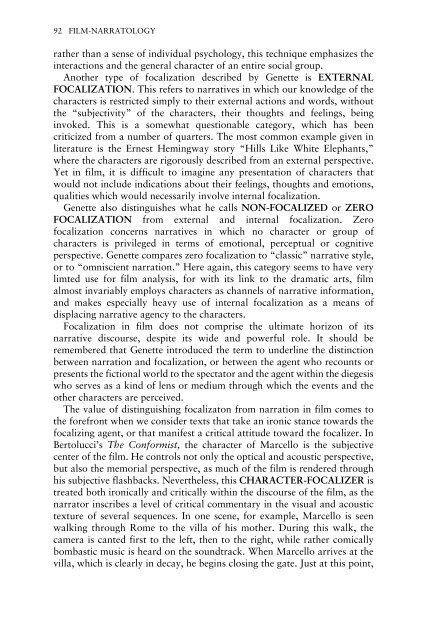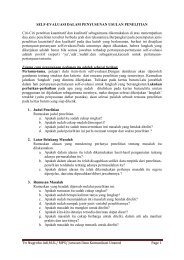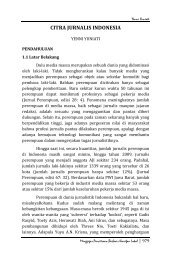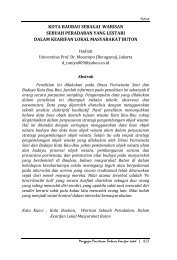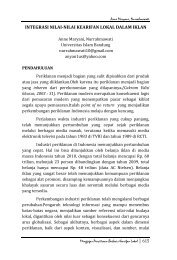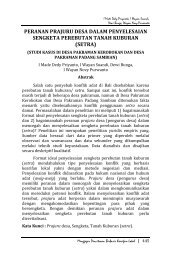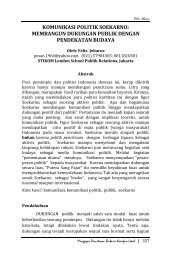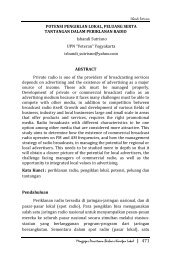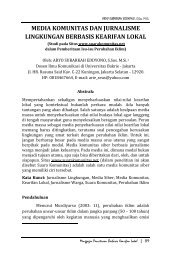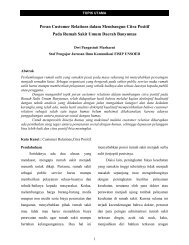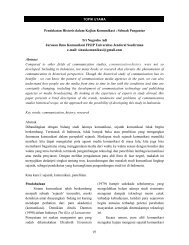New Vocabularies in Film Semiotics
New Vocabularies in Film Semiotics
New Vocabularies in Film Semiotics
Create successful ePaper yourself
Turn your PDF publications into a flip-book with our unique Google optimized e-Paper software.
92 FILM-NARRATOLOGY<br />
rather than a sense of <strong>in</strong>dividual psychology, this technique emphasizes the<br />
<strong>in</strong>teractions and the general character of an entire social group.<br />
Another type of focalization described by Genette is EXTERNAL<br />
FOCALIZATION. This refers to narratives <strong>in</strong> which our knowledge of the<br />
characters is restricted simply to their external actions and words, without<br />
the “subjectivity” of the characters, their thoughts and feel<strong>in</strong>gs, be<strong>in</strong>g<br />
<strong>in</strong>voked. This is a somewhat questionable category, which has been<br />
criticized from a number of quarters. The most common example given <strong>in</strong><br />
literature is the Ernest Hem<strong>in</strong>gway story “Hills Like White Elephants,”<br />
where the characters are rigorously described from an external perspective.<br />
Yet <strong>in</strong> film, it is difficult to imag<strong>in</strong>e any presentation of characters that<br />
would not <strong>in</strong>clude <strong>in</strong>dications about their feel<strong>in</strong>gs, thoughts and emotions,<br />
qualities which would necessarily <strong>in</strong>volve <strong>in</strong>ternal focalization.<br />
Genette also dist<strong>in</strong>guishes what he calls NON-FOCALIZED or ZERO<br />
FOCALIZATION from external and <strong>in</strong>ternal focalization. Zero<br />
focalization concerns narratives <strong>in</strong> which no character or group of<br />
characters is privileged <strong>in</strong> terms of emotional, perceptual or cognitive<br />
perspective. Genette compares zero focalization to “classic” narrative style,<br />
or to “omniscient narration.” Here aga<strong>in</strong>, this category seems to have very<br />
limted use for film analysis, for with its l<strong>in</strong>k to the dramatic arts, film<br />
almost <strong>in</strong>variably employs characters as channels of narrative <strong>in</strong>formation,<br />
and makes especially heavy use of <strong>in</strong>ternal focalization as a means of<br />
displac<strong>in</strong>g narrative agency to the characters.<br />
Focalization <strong>in</strong> film does not comprise the ultimate horizon of its<br />
narrative discourse, despite its wide and powerful role. It should be<br />
remembered that Genette <strong>in</strong>troduced the term to underl<strong>in</strong>e the dist<strong>in</strong>ction<br />
between narration and focalization, or between the agent who recounts or<br />
presents the fictional world to the spectator and the agent with<strong>in</strong> the diegesis<br />
who serves as a k<strong>in</strong>d of lens or medium through which the events and the<br />
other characters are perceived.<br />
The value of dist<strong>in</strong>guish<strong>in</strong>g focalizaton from narration <strong>in</strong> film comes to<br />
the forefront when we consider texts that take an ironic stance towards the<br />
focaliz<strong>in</strong>g agent, or that manifest a critical attitude toward the focalizer. In<br />
Bertolucci’s The Conformist, the character of Marcello is the subjective<br />
center of the film. He controls not only the optical and acoustic perspective,<br />
but also the memorial perspective, as much of the film is rendered through<br />
his subjective flashbacks. Nevertheless, this CHARACTER-FOCALIZER is<br />
treated both ironically and critically with<strong>in</strong> the discourse of the film, as the<br />
narrator <strong>in</strong>scribes a level of critical commentary <strong>in</strong> the visual and acoustic<br />
texture of several sequences. In one scene, for example, Marcello is seen<br />
walk<strong>in</strong>g through Rome to the villa of his mother. Dur<strong>in</strong>g this walk, the<br />
camera is canted first to the left, then to the right, while rather comically<br />
bombastic music is heard on the soundtrack. When Marcello arrives at the<br />
villa, which is clearly <strong>in</strong> decay, he beg<strong>in</strong>s clos<strong>in</strong>g the gate. Just at this po<strong>in</strong>t,


